![]()
| Data Interface with External Softwares > Analysis data |
|
|
|
|
||
Analysis data
The analysis data are generated as results of finite element processing either by VisualFEA or by an external solver. In order to visualize the analysis data by VisualFEA, they should be appended to the end of the modeling data in the same VisualFEA file.
> Analysis data master record
Analysis data master record consists of the solver's identification and basic information on the analysis items. The record has 30 entities of 4 byte long integer. The blank spaces are reserved for future use.
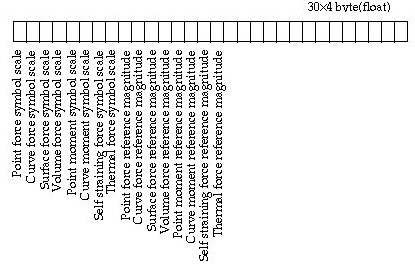
<Analysis data master record>
|
Solver ID No.: A number given to the solver in order to identify the external solver. In order to avoid conflict due to assigning the identical number for different solvers, it is advisable to use a large number within the range of 4 byte long integer. |
||
|
Solver version No.: Solver's version No if any. This value should be an integer number. This entry may be used to overcome incompatibility between different versions of the solver. |
||
|
Reanalysis code: This entry indicates whether the matrix file necessary for reanalysis is retained or not. The matrix file may be either saved for reanalysis or removed at the end of the finite element processing, depending on the setting of the solver options. |
||
|
0: The matrix file was removed. Reanalysis mode is not allowed. |
||
|
1: The matrix file was save. Reanalysis mode is allowed. |
||
|
Number of analysis data items: The number of data items obtained from the finite element processing, and written in the VisualFEA file. |
||
|
Number of contour menu items: The number of popup menu items in the "Contour" dialog for contouring of the analysis data. |
||
|
The contour menu items may be customized by the external solver. It is the responsibility of the solver to count the custom popup menu items and write the number into this entry. |
||
|
Number of vector menu items: The number of popup menu items in the "Vector" dialog for contouring of the analysis data. |
||
|
Displacement item entry: This entry directs the displacement data position entry in the analysis data position record. |
||
|
Maximum number of adaptive iteration cycles: The maximum number of iteration cycles is set as a criterion of terminating the iteration, prior to adaptive processing. This value is used to secure the space of the adaptive analysis data position record, and is ignored for non-adaptive analysis. |
||
|
Number of load increments: The value of this entry is used to secure the space of the nonlinear analysis data position record, and is ignored for linear analysis. |
||
|
Number of time steps: The value of this entry is used to secure the space of the dynamic analysis data position record, and is ignored for static analysis. |
||
|
Number of adaptive analysis solution data sets: The number of data sets including the intermediate and the final data sets obtained from adaptive analysis process. |
||
|
0: for non-adaptive analysis. |
||
|
2: for adaptive analysis in which only the data sets of the initial and the final stages are stored. |
||
|
3 or greater: for the data sets of the intermediate as well as the initial and the final stages.ediate and the final time steps of dynamic analysis. This entry is ignored for static analysis. |
||
|
Number of nonlinear analysis solution data sets: The number of data sets stored in the intermediate and the final steps of load increments for nonlinear analysis. |
||
|
0: for linear analysis. |
||
|
1: for nonlinear analysis in which only the final solution is stored. |
||
|
2 or greater: for nonlinear analysis in which the intermediate data as well as the final solution data are stored. |
||
|
Number of dynamic analysis solution data sets: The number of data sets stored for the interm |
||
> Adaptive analysis data position record
Adaptive analysis data position record has the information on the offset distance, in bytes, from the beginning of the file to the starting point of each data sets stored for the intermediate process of an adaptive analysis. The record has entities of 4 byte long integers, as many as the maximum number of adaptive iterations. This record is included only in case of adaptive analysis.
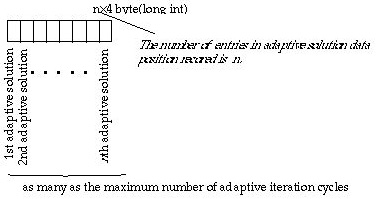
<Adaptive analysis data position record>
> Nonlinear analysis data position record
Nonlinear analysis data position record has information on the offset distance, in bytes, from the beginning of the file to the starting point of each data sets stored for the intermediate process of a nonlinear analysis. The record has entities of 4 byte long integer as many as the number of load increments. This record is included only in case of nonlinear analysis.
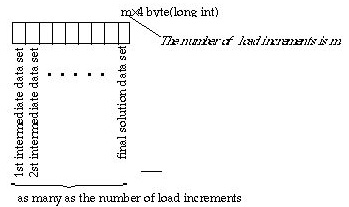
<Nonlinear analysis data position record>
> Dynamic analysis data position record
Dynamic analysis data position record has the information on the offset distance, in byte, from the beginning of the file to the starting point of each data sets stored for whole time steps of a dynamic analysis. The record has entities of 4 byte long integer as many as the number of time steps. This record is included only in case of dynamic analysis.
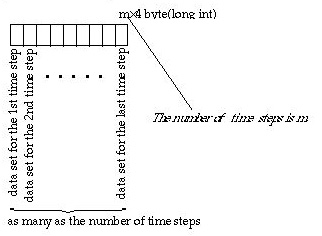
<Dynamic analysis data position record>
> Analysis data position record
Analysis data position record has information on the offset distance, in bytes, from the beginning of the file to the starting point of each analysis data item. The record has 30 entities of 4 byte long integer. The blank spaces are reserved for future use.
|
Analysis data item 1 through n : The positions of analysis data items. |
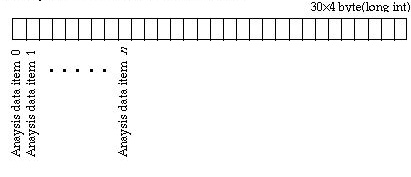
<Analysis data position record>
> Custom contour menu data
The popup menu items in "Contour" dialog can be customized by the external solver. For this purpose, the solver should write the following menu data in front of the analysis data in the VisualFEA file.
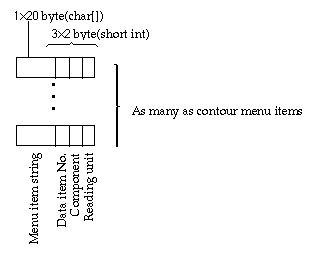
<Custom contour or vector menu data>
|
Menu item string: Menu string with 20 characters including blank space. The string appears as an popup menu item. |
||
|
Data item No.: The data with this item No. will be displayed when the menu item is chosen. |
||
| Component: The component of the data item to be displayed. | ||
| Entry No. or type: One component data consist of many data unit. Entry No. designates which entry out of a data unit is to be read and displayed. Entry type designates how a data unit is read and displayed. If this entry has a small integer value like 0,1,2,3,..., then this represent the entry No. Otherwise, this is relevant to entry type as follows ( The macro in the header file is shown within the parenthesis.): | ||
| 6000 (DISPLACEMENT_NORM) : Read all entries of each data unit, and make one norm of these values. For example, | ||
|
|
||
| 7000 (READ_ALL) : Read all entries of each data unit. | ||
> Custom vector menu data
The popup menu items in "Vector" dialog can be customized by the external solver in the same way as the case of "Contour" dialog.
> Analysis data items
The number of analysis data items are specified in the analysis data master record described above. Each data item is obtained as the final products of finite element processing, either by VisualFEA or an external solver. The analysis data have hierarchical construction of entry, data unit, component and item. Each data item consists of header and main body as shown in the following figure.
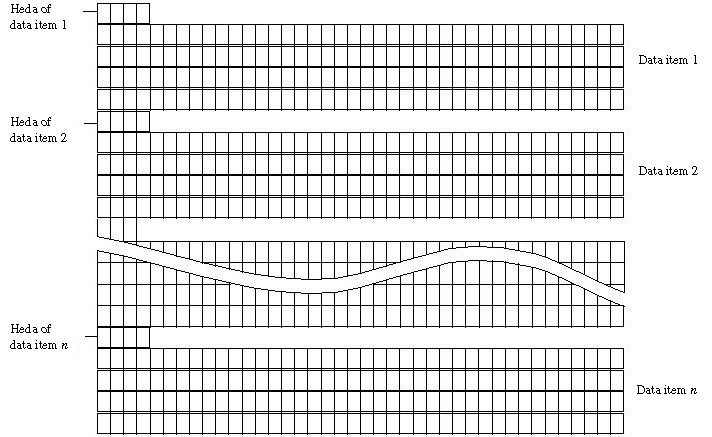
< Structure of analysis data>
The header record has the information on the hierarchical structure of the data. A data item is composed of a few components. A component has a number of data units. A data unit has a uniform or a variable number of consecutive data entries.
|
Number of components: One data item has either only one component or more than one components. This entry specifies the number of components composing the data item. |
||
|
Number of data units: Data unit is an aggregate of consecutive data entries which are read as one unit. There are number of data units in one component of a data item. This may be , for example, the total number of elements or the number of nodes, used in the model. |
||
|
Unit size: A data unit may have only one entry or a number of entries. the unit size may be uniform for all data units in the component, or may vary from unit to unit. For example, if the data item is the principal directions, the unit sizes are uniformly the same as the spatial dimension. If the data item is the displacements in a mixed structure, the unit sizes may not be uniform, because the number of nodal d.o.f. are not necessarily the same for all nodes. The following macro is defined for variable nodal d.o.f. in the header file. |
||
|
2000 (VARIABLE_NODAL_DOF) : A data unit consists of data entries as many as the nodal d.o.f. which varies from node to node. |
||
|
Writing rule: This entry specifies what a data unit is re p resented by. The following macros are defined in the header file. |
||
|
1 (WRITE_NODE) : A data unit matches with one node. So, there are as many data units as the number of nodes. |
||
|
2 (WRITE_ELEM) : A data unit matches with one element. So, there are as many data units as the number of elements. |
||
|
3 (WRITE_ELEM_NODE) : A data unit matches with each one of the nodes in an element. So, there are as many data units as the sum of the numbers of nodes in all elements. |
||
|
< Structure of an analysis data item> |
||
|
|
|
|